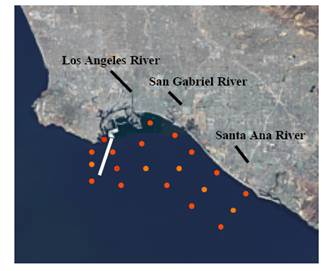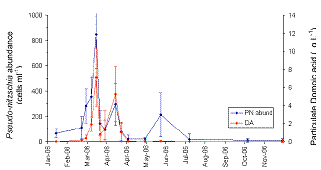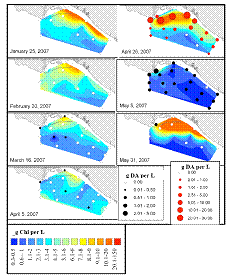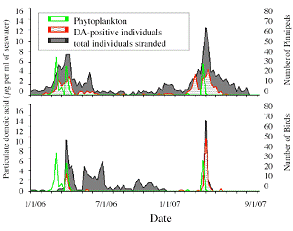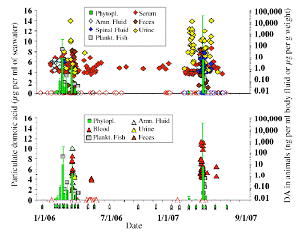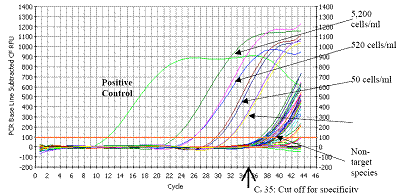Grantee Research Project Results
Final Report: Stimulation of Toxic Blooms of the Diatom Pseudo-nitzschia spp. by Urban River Discharge into Southern California Coastal Waters
EPA Grant Number: R831705Title: Stimulation of Toxic Blooms of the Diatom Pseudo-nitzschia spp. by Urban River Discharge into Southern California Coastal Waters
Investigators: Caron, David A. , Miller, Peter E. , Schnetzer, Astrid
Institution: University of Southern California , University of California - Santa Cruz
EPA Project Officer: Packard, Benjamin H
Project Period: September 1, 2004 through August 31, 2007 (Extended to August 31, 2008)
Project Amount: $350,765
RFA: Ecology and Oceanography of Harmful Algal Blooms (2004) RFA Text | Recipients Lists
Research Category: Aquatic Ecosystems , Water
Objective:
Summary/Accomplishments (Outputs/Outcomes):
The study area encompasses ~400 km2 off of the coastal Southern California Bight between the Palos Verdes Peninsula and Newport Beach (Figure 1).
Figure 1: Study region. During each survey, surface water was collected at 20 stations (dots). Three stations south of the Los Angeles Harbor (along white line) were sampled bimonthly to monitor for Pseudo-nitzschia presence between major sampling events.
Multiple surveys (weekly to monthly) were conducted throughout 2005, 2006, and 2007 to characterize the impact of river discharge on phytoplankton blooms in general, stimulation of blooms of the potentially toxic diatom Pseudo-nitzschia spp., and stimulation of the production of domoic acid (please find project results for 2005 and for the first half of 2006 detailed in prior progress reports).
2006 Summary: A Pseudo-nitzschia bloom dominated by P. australis was observed in the study area between February and May of 2006. Domoic acid concentrations reached their maximal levels during mid-March and a second peak occurred in mid-April (Figure 2). In contrast to March and April, cell abundances and toxin concentrations did not follow the same trend in June when an increase in P. australis numbers at several of the 20 sampling stations was not associated with increased domoic acid levels (Figure 2). Overall cell abundances ranged from <10 – 1,477 cells L-1 and domoic acid concentrations ranged from 0 – 14.4 _g DA L-1, with a mean of 171 cells L-1 and 1.26 _g DA L-1, respectively. Abundances and toxin levels were used to calculate per cell toxin quotas, which ranged from 0 – 66 pg DA cell-1 and averaged 6.03 pg DA cell-1.
Figure 2: Changes in Pseudo-nitzschia abundances (PN abund) and domoic acid (DA) concentrations observed in 2006. Values are shown as averages for all 20 sampling locations with their standard deviation.
The completion of the data analyses and processing of samples for biological (chlorophyll a, Pseudo-nitzschia abundances), physical (temperature, salinity), and chemical parameters (macronutrients PO4, NO3+NO2, Si(OH)4, domoic acid concentrations) was followed by multiple regression analyses to examine which environmental factors best correlated with particulate DA concentrations in the plankton (Table 1). Statistical testing showed that particulate DA concentrations were inversely correlated with silicate levels (p = 0.003) and positively correlated with nutrient ratios N: Si(OH)4 and P: Si(OH)4 (p = 0.1 and 0.001, respectively, Table 1). Particulate DA levels further increased with phytoplankton biomass (measured as chlorophyll a; p = 0.000) and decreased with surface water temperature (p = 0.001). These results were in good agreement with earlier field observations made during 2004 (Schnetzer, et al., 2007) and with results from laboratory studies that demonstrated that silica stress can increase toxin production in Pseudo-nitzschia spp.
Table 1: Results from multiple regression analyses (software package Statistica 6) examining relationships between particulate domoic acid concentrations and a variety of environmental parameters. Correlations that were significant at p < 0.05 are shown in blue (n = 139).
2007 Surveys: We continued to carry out our coastal surveys throughout 2007 and similarly to 2006, we observed a highly toxic bloom dominated by P. australis. In both years, maximal toxin concentrations occurred at stations closer to the coast, more specifically inside or immediately outside of the Los Angeles Harbor (Figure 3). Unlike the 2006 Pseudo-nitzschia bloom, abundances were observed no earlier than late April in 2007 and the bloom did not last longer than 1 month. Although overall bloom duration was shorter, toxin concentrations in excess of 25 μg DA L-1 were nearly double the highest values obtained during 2006 and were within the highest ever reported for natural algal assemblages. The color contours of Figure 3 are on the same scale to facilitate comparison of the two years.
The pattern and magnitude of the 2007 phytoplankton bloom (i.e., chlorophyll concentration) and domoic acid toxicity event are depicted in Figure 4 (shown are the results for 7 of the 11 surveys that were conducted). Note that there are two scales for the concentrations of domoic acid on this figure. The red dots indicate the extremely high values of domoic acid measured in plankton samples during late April 2007 (this panel is shown separately in Figure 3 to allow comparison with the bloom observed during 2006). The black and white dots indicate a different scale used to show the much lower concentrations of domoic acid before and only 1.5 weeks after April 26 (Figure 4).
The nutrient analyses and salinity measurements for 2007 have been completed at this time, and the total dataset has been analyzed. The 2006 and 2007 dataset is presently being prepared for publication, as is the qPCR approach for estimating abundances of Pseudonitzschia (see details below).
The analyses indicate that a major stimulant for the 2007 bloom was an upwelling event that occurred one week before the peak concentrations of domoic acid were observed. Two pieces of information support this preliminary conclusion. First, the year was one of the driest years ever on record and discharge from the Los Angeles River (which may play a role in some year’s blooms) was very low. Second, a significant decrease in water temperature was observed in the waters in and around the study site just prior to bloom initiation. This suggests that nutrient enrichment due to a local upwelling event may have triggered the bloom. This hypothesis is being tested as we complete all datasets for 2007, and multivariate statistics are being completed. The analysis entails statistical analysis of the entire Ecohab dataset, which comprises a total of 39 surveys that were conducted between 2005 and 2007.
Figure 3: Spatial distribution of maximal particulate domoic acid concentrations in surface waters of the San Pedro Shelf area during 2006 and 2007. Highest domoic acid concentrations were detected inside the Los Angeles/Long Beach Harbor in March 2006 (>14 _g DA L-1) and immediately outside of the harbor breakwater during April 2007 (>26 _g DA L-1).
Summary of 2007 and 2008 Toxic events and Correlation With Marine Animal Illness: The toxic events detailed above resulted in significant marine animal mortality. Our group requested a small supplement and a time extension on the grant to analyze additional samples of animal fluids and tissues. These samples were collected by several animal rescue and care centers with which we have established collaborative relationships (see “Partnerships Established” below). The purpose of this component of the project was to begin to link domoic acid concentrations in the plankton of this coastal ocean region to impacts on the health of marine animals (primarily marine mammals and sea birds). During the 2006 and 2007 domoic acid toxicity events, in the plankton we observed a strong correlation with the number of animal strandings (Figure 5), and also with the body burdens of domoic acid in these animals (Figure 6).
Figure 5. Temporal distribution of domoic acid in phytoplankton biomass (green lines), total number of sick animals stranding on the shore (top, pinnipeds; lower sea birds), and number of stranded animals testing positive for domoic acid during our study during 2006 and 2007. Note the strong overlap between spring toxic events and animals testing positive for domoic acid.
Figure 6. Temporal coincidence of domoic acid concentrations in planktivorous fish (gray squares), phytoplankton (green bars), and domoic acid concentrations in the body fluids and/or tissues of marine mammals and birds. Note the log scale for the values of animal body burdens. Generally, for animals testing positive, vastly higher concentrations of domoic acid were observed in animals during toxic bloom events.
Animal rescue and care centers provided samples of tissue, fluids, stomach contents, and fecal material for domoic acid analysis for the past 2 years. The appearance of toxins in the plankton resulted in an increased number of sea lions being received by mammal care facilities within 3 days. Bloom duration and overall toxicity of the bloom was reflected in the number of animal strandings. Furthermore, domoic acid levels in serum samples were highest when concentrations in the plankton reached maximal levels.
More than ten coastal species (mainly birds) that had not been implicated with domoic acid poisoning previously have tested positive for the algal toxin since early 2006. These results are now being summarized for publication.
Development of a genus-specific qPCR approach: Pseudo-nitzschia species isolations, identifications, and the development of quantitative real-time PCR have been accomplished during the last project year. The isolation and identification (via scanning electron microscopy and sequencing of small subunit ribosomal RNA genes) of local Pseudo-nitzschia species has been conducted from samples collected throughout 2005 and 2006. Pseudo-nitzschia species that were identified as members of the plankton in the study area included P. australis, P. fraudulenta, P. delicatissima, P. multiseries, P. pungens, P. seriata, P. pseudodelicatissima, and P. cf. cuspidata. Microscopical identification in Peter Miller’s laboratory coupled with DNA sequencing in Caron’s laboratory have provided the basis for a SYBR Green qPCR approach to detect all of the species within the genus of Pseudo-nitzschia.
Figure 5. Dilution curve for P. australis culture. The detectable range for cell abundances ranged from 5,200 to 5 cells ml-1. Plasmid DNA was used as a positive control in each reaction (Ct = 12). Test runs with more than 30 non-target protistan species were performed to confirm specificity (non-target species did not yield fluorescence above background levels; indicated here as a cut off at Ct = 35).
The newly developed protocol allows for the detection of Pseudo-nitzschia abundances over four orders of magnitude (shown for P. australis in Figure 5). Amplification of non-target species only occurred after more than 36 cycles and allowed for the determination of a cut-off point for non-specific signal yield relative to the lowest resolved culture dilution of P. australis with 5 cells ml-1 (Ct = 32). More than 30 protistan species were chosen for specificity tests from the laboratory culture collection and all of them fell below our lower detection limit. In contrast, all of the available Pseudo-nitzschia extracts (total of eight different species) resulted in a significant fluorescence yield and were detectable using the approach (not shown). The approach is now being prepared for publication.
Partnerships Established: We have established working partnerships/relationships with a variety of research institutions, management groups, state and local agencies, and animal rescue and care groups. These include the following:
- CA Department of Public Health
- Southern California Coastal Ocean Observing System
- Southern California Coastal Water Research Project
- Southern California Marine Consortium
- LAC Sanitation District
- OC Sanitation District
- Wrigley Institute for Environmental Studies
- Fort McArthur Marine Mammal Care Center, San Pedro, CA
- Pacific Marine Mammal Center, Laguna Beach, CA
- National History Museum, Section of Mammalogy, Los Angeles, CA
- International Bird Rescue Research Center, San Pedro, CA
- Wetlands and Wildlife Care Center, Huntington Beach, CA
- Whale Rescue Team, South Bay, CA
Journal Articles on this Report : 3 Displayed | Download in RIS Format
| Other project views: | All 41 publications | 5 publications in selected types | All 4 journal articles |
|---|
| Type | Citation | ||
|---|---|---|---|
|
|
Caron D. New Accomplishments and Approaches for Assessing Protistan Diversity and Ecology in Natural Ecosystems. BIOSCIENCE 2009;59(4):287-299. |
R831705 (Final) |
Exit Exit |
|
|
Fitzpatrick E, Caron D, Schmetzer A. Development and environmental application of a genus-specific quantitative PCR approach for Pseudo-nitzschia species. MARINE BIOLOGY 2010;157(5):1161-1169. |
R831705 (Final) |
Exit Exit |
|
|
Schnetzer A, Jones B, Schaffner R, Cetinic I, Fitzpatrick E, Miller P, Seubert E, Caron D. Coastal upwelling linked to toxic Pseudo-nitzschia australis blooms in Los Angeles coastal waters, 2005-2007. JOURNAL OF PLANKTON RESEARCH 2013;35(5):1080-1092. |
R831705 (Final) |
Exit Exit |
Supplemental Keywords:
Marine, southwestern coastal ocean, toxicity, domoic acid, plankton, phytoplankton, Pseudo-nitzschia, ecosystem damage, environmental biology, ecology, remote sensing, satellite, immunology, molecular biology, microscopy., RFA, Scientific Discipline, Water, Geographic Area, Ecosystem Protection/Environmental Exposure & Risk, estuarine research, State, Oceanography, algal blooms, Wet Weather Flows, Environmental Monitoring, Ecological Risk Assessment, Ecology and Ecosystems, Aquatic Ecosystem Restoration, monitoring, risk assessment, aquatic ecosystem, environmental restoration, wetlands, river discharge, estuaries, bloom dynamics, watershed, downstream effects, precipitation monitoring, conservation, restoration strategies, aquatic degradation, environmental stress, combined sewer overflows, environmental indicators, California (CA), algal bloom detection, storm drainage, stormwater runoff, storm events, contaminated waterfronts, groundwater pollution, domoic acid producing diatoms, real-time monitoringRelevant Websites:
http://www.usc.edu/dept/LAS/biosci/Caron_lab/index.htmlProgress and Final Reports:
Original AbstractThe perspectives, information and conclusions conveyed in research project abstracts, progress reports, final reports, journal abstracts and journal publications convey the viewpoints of the principal investigator and may not represent the views and policies of ORD and EPA. Conclusions drawn by the principal investigators have not been reviewed by the Agency.

